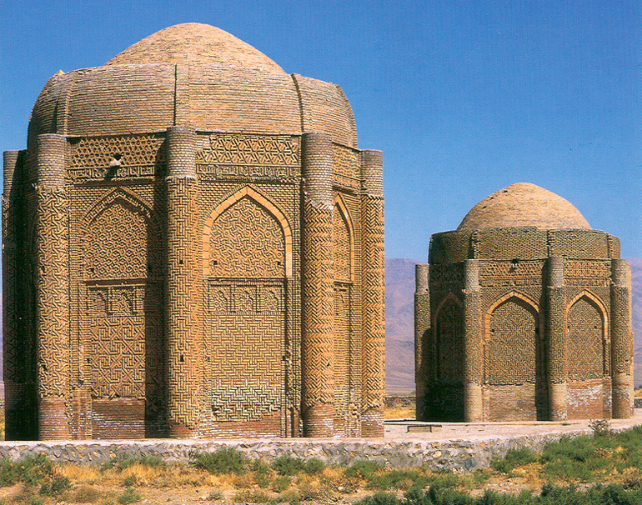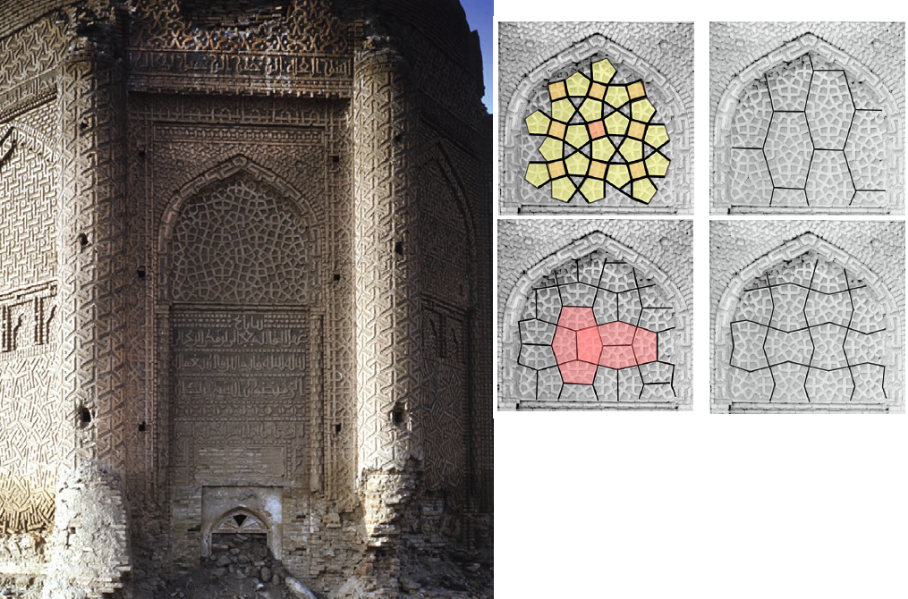an alternative approach
parallels
The Seljuk monuments bear an unknown variety of forms and decorations. Most common is the octagon, together with 2-, 4- and 8-fold symmetries. Also 3- and 6-fold symmetries appear more frequently than 5- and 10-fold. In Maragha Bier finds parallels in other pre-Mongol monuments on the Iranian plateau, e.g. the two Kharraqan towers. The decoration on the tympans can be read in different ways.


art and knowledge
Carol Bier emphasizes the importance of the pre-Mongolse Iranian shrines in the funeral architecture. In later Islamic architecture they will grow out to the most important architectural achievements and models for the shrine of Timur in Samarkand (15th C) and the Taj Mahal in Agra (17th C) and this emphasis is not incidental. For her it’s above all not a matter of quasi-periodicity or not, but an expression of scientific thinking at that time. For many reasons this interdisciplinary discussion is not easy, not in the least due to our Western look in history (of arts). Bier suggests that the mathematical knowledge at that time, starting from translations of Euclid and others, found its expression in experiments with form and decoration. Islamic art is nor representative but expressive.

Kharam mukhammas (pentagonal seal)
An undated Persian document in the Bibliothèque Nationale in Paris mentions the title 'karam mukhammas' and illustrates how overlapping decagonals create a regular 5-pointed star. A year after Lu and Steinhardt Saltzman used it to create an alternative underlying pattern for the pattern of the Gunbad-i Kabud. Comparing his solution (left) with the girih solution (right), you can see that the bow ties and hexagons follow logically the overlapping decagons. The 5-pointed stars too are circumscribed by a decagon and who’s familiar with Penrose immediately sees how Penrose deducted his kite and dart out of this configuration. So the link between de decorations and Penrose isn’t as unexpected as one would expect.

missing link?
Carol Bier writes that by linking these mukhammas to the Maragha pattern maybe a link cn be deducted between the history of mathematical knowledge and history of art, a link that’s rather vague fort his period. Lu en Steinhardt ignore the relevance of overlapping decagons for the Maragha pattern. While Lu ans Steinhardt isolate the girih pattern in Maragha as a break through regarding to constructions with ruler and compass, Bier stays closer to the historical background and contextual parallels.
conclusion
Looking at the combination of form and decoration of the Gunbad-i Kabud it’s clear that there’s a strong emphasis on geometry. The visual complexity of the decorative pattern with local 5-fold and 10-fold symmetry is significant within the context of a group actively engaged mathematicians testing out the visual aspects of their theoretical aspects. However their existence in pre-Mongols Maragha is speculation, it’s substantiated by the choice for Maragha as location for an astronomical centre after the Mongol conquest. At the same time the Gunbad-i Kabud fits into a greater story we can follow in the funeral
architecture on the Iranian plateau, in which we meet a story of growing knowledge and complexity. Starting with elementary patterns, based on an elementary knowledge of symmetry and evolving by experiments with overlapping polygons and star patterns: from 3- and 6-pointed stars, squares and 8 pointed stars to 5-, 6- and 7-pointd stars and overlapping decagons. Parallel with these extraordinary and creative developments in decorative patterns texts of mathematicians appear showing the applications of them in the monuments. According to Carol Bier this is potentially very worthwhile to understand the history of art and architecture as well as the history of mathematics.